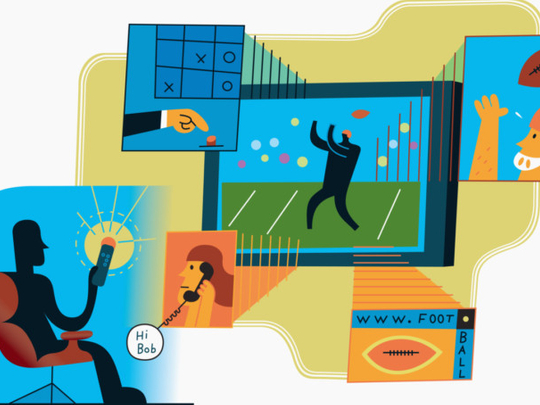
You are watching a horror flick on your 60-inch TV. It’s a tense moment — a killer is on the loose and the protagonist is on the run. She finds a lonely corner to hide, pulls out her phone and starts texting for help. Just then your phone buzzes. You pull it out, and there it is — her text message! On your phone! And there she is, looking at you from the TV screen, waiting for your response.
Blame APP
Similar ideas were, in fact, showcased in a Dutch movie released a few months ago. Called APP, you need to install a supporting Android or iOS app on your phone or tablet before watching it. Throughout the movie, audio cues are sent to the app, which trigger certain actions such as the phone vibrating in your pocket as and when it does on screen. The movie is being distributed internationally by High Point. And as Piers Nightingale, its Director of Acquisitions, explains to Variety, “The story feeds the app and the app feeds the story.” Carey Fitzgerald, Managing Director of High Point, believes it’s a showcase of “thrilling creativity and innovation in the way it seeks to unite different media platforms”.
APP is an intriguing example of a “second screen experience” where what is happening on the big TV (the first screen) is complemented by what is happening on your phone/tablet (the second screen). Another example is Disney’s experiment with Little Mermaid, where in September fans landed for a special screening, iPads in tow. Throughout the movie, the tablets were used to dish out activities such as puzzles and sing alongs, which were in sync with the unfolding movie. Liz Shannon Miller, writer and a video show’s co-host, observes on the tech blog, Gigaom.com, “By bringing gamification to the second screen, Disney has found a way to make even the most familiar of films into an interactive and engaging experience.”
Parallel path
The use of second screen provides a parallel path, whereby the user can become an active agent in the broadcast content. It is a great way for broadcasters and channels to create a loop between the TV and the portable device. OSN, the pay TV network with the largest subscriber base in the UAE, is already investing heavily on its OSN Play app. Unveiled in July, the mobile app currently lets users watch on-demand shows. But CEO David Butorac reveals the next step is to bring in second screen experiences by streaming information related to what is playing on TV.
“Let’s say you’re watching the exclusive coverage of European Tour golf on OSN [on TV]. You can have your second screen with all the golf stats on it,” Butorac told media.
The possibilities for second screen experiences are endless — a football match could be backed by past data, while a reality show could be enhanced with live polls. In fact, reality shows and sports are two prime candidates for second screen experiences. These categories are popular in the UAE. According to the television audience measurement agency, Tview, the most tuned in programme on TV this year was the finale of the Arab Idol — more than 400,000 watched it. This viewership was higher than the 300,000 who watched the UAE win Gulf Cup finals earlier this year. And those numbers will only skyrocket as the total base of TV users grows rapidly. Research firm Informa expects the Mena region to add 14 million TV households by 2014, taking the total to 90 million. Add to this the popularity of social networks, especially Twitter. According to market research firm GlobalWebIndex, in the fourth quarter of 2012, 51 per cent of all internet users in Saudi Arabia were active on Twitter, followed by 39 per cent from Turkey and 34 per cent from the UAE.
Shailesh Rao, Twitter’s Head of Emerging Markets, reveals that the Mena accounts for 6 per cent of Twitter’s active users, and most of them tweet via their mobile phones. As Rao noted earlier this year at a press conference, “The active user base in the Middle East has tripled in the last year. It’s one of the fastest-growing regions in the world.”
No wonder Twitter is pursuing partnerships with TV broadcasters all over the world. Incidentally, Facebook is also catching up with APIs that track real-time activity related to TV shows.
Meanwhile, the 2012 Nielsen TV and Twitter relationship study reveals that in the US, 80 percent used smartphones or tablets while watching TV, while 32 million tweeted about what they were watching. In fact, there is a strong correlation between Twitter activity and a show’s TV rating. For instance, MTV UK’s Hottest Summer Superstar garnered more than 166 million tweets, which translated into a 22 per cent boost in viewership ratings. X Factor Arabia has been one of the biggest hits locally.
Audiences multi-task
Audiences seem adept at multi-tasking between social updates and TV viewing. A study released by Nielsen’s SocialGuide in September this year discovered a surprising fact — commercial breaks were not tweet breaks. In fact, 70 per cent of show-related tweets were sent while the programme was on, and 30 per cent during commercial breaks.
Second screen experience is drawing interest from varied quarters. Companies such as Shazam and Gracenote are experimenting with audio-fingerprinting so that the tablet app can intelligently recognise what you are watching on TV. Efforts are also on to create video loops — imagine a special logo appearing on your TV during a show. You point the phone’s camera to it and that triggers an action on your mobile, it could be a related video, contest or even earn you loyalty points for watching the show. Similar to what companies such as Viggle and GetGlue do, reward users for checking in their TV viewing.
Gaming is also a hot area for second screen experiments. In ZombiU, for instance, the second screen is used to rummage through the bag you carry in-game. Dead Rising 3, meanwhile, integrates the interface of its phone app with the one used by the main character in the game.
Finally, while second screen experiences flowed from a TV to tablet, a new trend is reversing the direction. With the growing popularity of cheap TV dongles such as the $35 (around Dh128) Google Chromecast and wireless mirroring using Miracast or Airplay, users can now start a session on the tablet and fling it to the TV. In fact, the lines between what is first and second screen have already blurred.
Though the biggest challenge remains — gauging your interests and tailoring the second screen content accordingly. Or not showing it at all. As Jim Monroe, Co-Founder and SVP of programming at Net2TV, argues in Huffington Post, “A few years ago, if a show lost my attention, I picked up a magazine or changed the channel. Today, I’m more likely to grab a second screen, my iPad or smartphone. But to do what? Facebook? Email? Amazon? Sure. After all, when a show lets you down, there’s always shopping. But launch a second screen app with more information about the show I’ve just abandoned? That doesn’t sound right, does it?”












